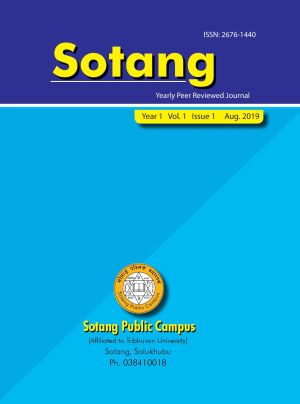कक्षामा बहुभाषिकता सम्बोधनका चुनौती {Challenges of addressing multilingualism in the classroom}
DOI:
https://doi.org/10.3126/sotang.v1i1.45843Keywords:
लिपिगत, भाषिक विश्लेषण, मानक चयन, बहुभाषिकता, भाषिक सर्वेक्षणAbstract
विश्वव्यापी रूपमामानव अधिकार, बाल अधिकार, अल्पसङ्ख्यक अधिकार, आदिबासी जनजाति अधिकारआदि विभिन्न अन्तर्राष्ट्रिय सन्धि सम्झौताहरूमा भाषिक विविधता सम्बोधन गर्नका लागि व्यवस्था गरिएको पाइन्छ । नेपालले ती विभिन्न अन्तर्राष्ट्रिय सन्धिसम्झौता तथा समझदारी पत्रमा हस्ताक्षर गर्नुका साथैसंविधान, ऐननियम, पाठ्यक्रम, शैक्षिक योजना तथा कार्यक्रममा बहुभाषिकता सम्बोधनका लागि स्पष्टव्यवस्था गरेको छ तर यस्तो व्यवस्था प्रभावकारी रूपमा कार्यान्वयन हुन नसकेको देखिन्छ । विगतको लामोएकभाषिक नीतिको प्रभाव र बहुभाषिक शिक्षाको व्यवहारिक अनुभवको अभावले बहुभाषिकता सम्बोधनमाविभिन्न चुनौतीहरू देखिएका छन् । नेपालको समग्र बहुभाषिकताको भाषिक सर्वेक्षण तथा विश्लेषण नहुनु,विभिन्न भाषाभाषीको बसोवास छरिएर रहनु, एउटै कक्षामा धेरै मातृभाषी विद्यार्थीको असमान वितरण हुनु, अभिभावकहरूमा मातृभाषाप्रति अनास्था र अंग्रेजी तथा नेपाली भाषाको मोह हुनु, पाठ्यक्रम एवं पाठ्यसामग्री निर्माण तथा शिक्षणका लागि दक्ष एबं तालिम प्राप्त जनशक्तिको अभाव, एउटै कक्षामा बहुभाषिक विद्यार्थीहुनु, स्तरीय पाठ्यसामग्रीको अभाव जस्ता समस्याले बहुभाषिकताको सम्बोधनमा चुनौती थपेका छन् । साथैअधिकांश भाषाको लेख्य रूप नहुनु, लेख्य रूप भएका भाषाको पनि मानक चयनमा समस्या हुनु, लिपिगत समस्या हुनु, आवश्यक पूर्वाधारको कमी तथा सरोकारवाला निकाय बीच समन्वयको अभाव पनि चुनौतीकारूपमा रहेका छन् ।
{Provisions have been made to address linguistic diversity in various international treaties, such as human rights, child rights, minority rights, and indigenous peoples' rights. Nepal has signed various international treaties and memoranda of understanding and has made clear provisions for addressing multilingualism in constitutions, by-laws, curricula, educational plans and programs, but such provisions have not been implemented effectively. The impact of the long monolingual policy of the past and the lack of practical experience in multilingual education has posed various challenges in addressing multilingualism. Lack of linguistic survey and analysis of the overall multilingualism of Nepal, scattering of different language speakers, unequal distribution of many mother tongue students in the same class, distrust of parents towards mother tongue and love of English and Nepali language, skilled and trained manpower for curriculum development and teaching Problems such as lack of multilingual students in the same class, lack of standard textbooks have added challenges in addressing multilingualism. In addition, most of the languages do not have written form, even the written language has problems in standard selection, script problems, lack of necessary infrastructure and lack of coordination among the concerned bodies are also challenging.}




